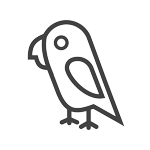
Italian Greyhound: The Ultimate Guide to This Elegant Breed
There’s something undeniably special about the Italian Greyhound. Maybe it’s their fine-boned elegance, their gentle eyes, or that way they seem to glide when they move. But don’t let their refined looks fool you—these dogs are total lovebugs. One minute they’re curled up like a croissant on your lap, the next they’re sprinting through the yard like they’ve been shot out of a cannon.
These little legends have been warming laps since the days of ancient Rome, and their charm clearly hasn’t worn off. Whether you’re eyeing Italian Greyhound puppies or just can’t get enough of their quirky ways, there’s so much to love—and learn—about this breed.
In this guide, we’ll dig into everything from Italian Greyhound size and coat colours (ever heard of the stunning blue Italian Greyhound?) to how they’re different from Whippets, what they’re like with kids, and how to care for their dainty frames. We’ll also talk health, grooming, training, and whether it’s better to buy or adopt an Italian Greyhound in Australia.
So, if you’ve been wondering “do Italian Greyhounds shed?” or “are they good with other pets?”—you’re in the right place. Let’s get into it.
Absolutely—here’s the next section, fully fact-checked and written in a conversational, engaging tone that blends topical authority with natural keyword use.
A Glimpse Into History – The Italian Aristocrat of Dogs
The Italian Greyhound may be petite, but its history is anything but small. This elegant breed has been turning heads for thousands of years—literally. Archaeological digs in modern-day Turkey and Greece have unearthed small greyhound-like dog remains dating as far back as 2,000 years ago. These little dogs were popular companions in ancient civilisations, especially across southern Europe.
But it was in Italy—during the Renaissance—that the breed truly found its groove. Italian nobility fell in love with their refined looks and loyal nature. These dogs weren’t bred to hunt; they were bred to be adored. You’ll find them immortalised in portraits by famous artists like Giotto and Van Dyck, lounging beside kings, queens, and ladies of the court. They were lapdogs of the elite, often gifted between royals, and a favourite of aristocrats across Europe.
Famous Italian Greyhound fans included:
-
Catherine the Great of Russia, who reportedly had several
-
Queen Victoria, known for her love of small dogs
-
Frederick the Great of Prussia, who was even buried with his Italian Greyhound, Biche
Despite their ancient roots, the breed’s refined frame hasn’t changed much over the centuries. They’ve always been small, sleek, and built for speed—though today they’re much more likely to race for a spot on your couch than in the field.
In Australia, Italian Greyhounds are still considered a niche breed but have a loyal and growing fanbase. With their compact size, affectionate nature, and low-shedding coat, they’ve found their way into modern homes as loving companions who adore human attention.
Personality, Appearance & Temperament
When you first meet an Italian Greyhound, it's hard not to be enchanted. With their elegant build and sweet expression, they look like little four-legged supermodels. But spend a bit of time with one, and you’ll quickly realise there’s a whole lot more going on beneath that sleek exterior.
Personality: Affectionate, Sensitive, and a Little Bit Silly
Italian Greyhounds are the ultimate velcro dogs. They bond fiercely with their humans and prefer to be wherever you are—whether that’s curled up under your blanket, resting their head on your laptop, or shadowing you around the house like a fluffy stalker. They're known for their sensitive and affectionate nature, often forming a deep attachment to one person in particular.
Don’t be surprised if your Iggy demands to sleep in your bed (under the doona, thank you very much) or gets a bit anxious when you leave the room. They're not the type of dog that enjoys long stretches alone—separation anxiety can be a real challenge with this breed.
That said, they’re also playful and quirky. Many Italian Greyhound owners joke that their dogs are part cat, part toddler, and part Olympic sprinter.
Appearance: The Picture of Grace
These pups are the smallest members of the sighthound family. Standing around 33–38 cm tall and weighing just 3.6–5 kg, they’ve got long, narrow faces, deep chests, and those signature slender legs. Despite their fine-boned look, they're strong and built for speed—just not roughhousing.
Their coat is short, smooth, and lies flat against the skin, which gives them that polished, almost statuesque look. And because they’ve got such low body fat and minimal fur, you’ll often find them seeking warmth (like burrowing into a PaWz calming bed or snuggling inside a jumper).
Temperament: Calm But Energetic
Italian Greyhounds are generally quiet dogs. They’re not big barkers, and they thrive in calm, loving homes. But don’t be fooled—they do get bursts of energy that have them zooming wildly around the house or garden. These quick sprints, often called “zoomies,” are completely normal and part of their charm.
They’re typically shy or reserved with strangers but rarely aggressive. With early socialisation, they can learn to be more confident and comfortable in new situations.
Italian Greyhound Size – Just How Small Are They?
If you’re picturing a Greyhound and thinking, “Too big for my home,” don’t worry—Italian Greyhounds are their mini-me cousins. They’ve got all the elegance, speed, and long-legged charm of a Greyhound, but in a daintier, more lap-sized package.

Average Size at a Glance
-
Height: 33–38 cm (measured at the shoulder)
-
Weight: 3.6–5 kg (some petite ones may weigh slightly less)
-
Build: Slender, fine-boned, with long legs and a deep chest
Despite their lean appearance, Italian Greyhounds are surprisingly strong for their size. But their delicate legs are prone to injury—especially during puppyhood when they're still developing coordination. That’s why they’re better suited to gentle play and indoor living, especially in multi-dog households with larger or boisterous pups.
What’s the Smallest Italian Greyhound?
Some breeders advertise “teacup” or “miniature” Italian Greyhounds, but officially, there’s only one recognised size. True teacup versions often result from unethical breeding practices focused on shrinking size at the cost of health. A healthy Italian Greyhound puppy should grow to around the standard size range mentioned above. If you see one much smaller, proceed with caution and ask questions.
Small, Yes—but Not Fragile Furniture
It’s tempting to treat them like breakable china, but Italian Greyhounds are still active, athletic dogs. They love sprinting, playing, and even doing agility—on their own terms, of course. The key is providing a safe environment: think soft dog ramps, carpets over slippery floors, and avoiding high jumps from couches or beds. A raised orthopaedic dog bed or supportive mat can help cushion their joints and protect those long, elegant legs.
Whippet vs Italian Greyhound – Know the Difference
It’s a common question—and an understandable one. At first glance, Whippets and Italian Greyhounds look like siblings: both sleek, both leggy, and both sighthounds with a serious case of the zoomies. But once you know what to look for, the differences become crystal clear.
Size – The Most Obvious Difference
Let’s start with the numbers:
-
Whippet: 44–51 cm tall, weighing 9–19 kg
-
Italian Greyhound: 33–38 cm tall, weighing 3.6–5 kg
In person, the size gap is much more dramatic than photos suggest. Whippets are solidly medium-sized, while Italian Greyhounds are genuinely tiny. If you’re looking for a compact pup to suit an apartment or small home, the Iggy wins out on size alone.
Personality – Subtle but Distinct
-
Italian Greyhounds tend to be more sensitive and clingy. They love routine, warmth, and staying close to their humans—sometimes too close. They’re notorious lap lovers and can be anxious when left alone.
-
Whippets are a bit more independent. Still affectionate, but often a little more laid-back and tolerant of alone time. They also tend to be more confident in new environments.
Exercise Needs – Zoomies in Moderation
Both breeds are sprinters, not marathon runners. They thrive on short bursts of play and a good daily walk but don’t need hours of exercise.
-
Italian Greyhounds are more fragile and can tire easily, especially in cold or hot weather.
-
Whippets are sturdier and better suited to rougher outdoor play or longer romps.
Grooming, Shedding & Skin Care
Neither breed is high maintenance when it comes to grooming, and both are low shedders, though not completely hypoallergenic.
-
Italian Greyhounds have thinner skin and are more sensitive to cold. They benefit from cosy dog jumpers, heated beds, and indoor living.
-
Whippets handle weather slightly better but still appreciate a snug jumper when the mercury drops.
Which One’s Right for You?
If you want a truly tiny companion who thrives on closeness and indoor snuggles, the Italian Greyhound could be your match. If you love the look but prefer a sturdier, slightly more independent dog, a Whippet might be the better pick.
Looks, Colours & Markings – Spot the Elegance

The Italian Greyhound doesn’t need to try hard to turn heads. With their slender silhouette, graceful posture, and smooth, velvety coat, they look like they were sculpted by a Renaissance artist. But beyond the runway-ready frame, their colours and markings offer even more personality and variety.
Signature Look
Let’s break down the Iggy’s signature style:
-
Build: Long legs, deep chest, tucked-up waist—sleek and aerodynamic, made for short bursts of speed
-
Head: Narrow skull with a slight stop, long slender muzzle
-
Eyes: Large, dark, and expressive—they’ve mastered the sad-puppy look
-
Tail: Long and thin, usually carried low in a curve
-
Ears: Rose-shaped, folded back unless alert (then they perk into a V-shape)
Their short coat lies flat and smooth against the skin, giving them that glossy finish without the need for much grooming. But don’t be fooled—they may be low-maintenance, but their skin is delicate and prone to scrapes and chill.
Italian Greyhound Colours – What to Expect
Italian Greyhounds come in a lovely range of solid colours and combinations. The breed standard allows:
-
Fawn (ranging from pale cream to reddish)
-
Blue (a steel-grey shade, extremely popular and often more expensive)
-
Seal (almost black with a reddish tint under sunlight)
-
Black
-
Red
-
White (though rare as a solid colour)
-
Cream
You’ll also see a mix of white markings on the chest, face, and paws—though show standards in some countries prefer solid coats. Australian Iggies often come in varied and eye-catching combinations that don’t always fit the show-ring mould but are just as beautiful.
The Allure of the Blue Italian Greyhound
There’s something especially striking about the blue Italian Greyhound—a cool-toned, silvery-grey that seems to shimmer in the light. While it’s just a coat colour genetically (a dilution of black), it’s become one of the most in-demand hues in the breed.
Keep in mind: blue-coated dogs of any breed may have more sensitive skin and are sometimes more prone to colour dilution alopecia (a condition that can cause hair thinning). Always ask breeders about health screenings and coat care recommendations.
Common Health Conditions – What Every Owner Should Know
As dainty and graceful as they are, Italian Greyhounds do come with a few breed-specific health concerns worth knowing. Their slim frame, sensitive nature, and unique build mean they require a bit of extra care—especially when it comes to their bones, teeth, and skin.
Let’s take a closer look at the most common Italian Greyhound health problems, so you know what to expect and how to support your pup for a long, happy life.
1. Fragile Bones & Leg Fractures
Due to their fine-boned build, Italian Greyhounds—particularly puppies—are prone to broken legs and injuries from even minor falls or rough play. This is especially common in young Iggies under 18 months, when their bones are still developing.
Tip: Avoid high furniture, use dog ramps for beds and couches, and keep play gentle indoors.
2. Dental Disease
This is a big one. Italian Greyhounds are notorious for dental issues—from early tartar buildup to tooth loss. Their small mouths and genetics make them more vulnerable, so a proper dental routine is non-negotiable.
Tip: Regular brushing, dental chews, and vet check-ups help keep their teeth in check. Start dental care early with your Italian Greyhound puppy to make it a habit.
3. Hypothyroidism
Though not common, some Italian Greyhounds can develop hypothyroidism, where the thyroid gland doesn’t produce enough hormones. Signs include lethargy, weight gain, and thinning coat. It’s easily manageable with medication once diagnosed.
4. Epilepsy
Some bloodlines may carry a genetic predisposition to epilepsy, which causes recurring seizures. This condition can often be controlled with medication and regular monitoring.
5. Skin Sensitivity & Cold Intolerance
With their thin skin and almost no body fat, Italian Greyhounds feel the cold more than most breeds. You might notice them shivering or burrowing under blankets even on mildly cool days.
Absolutely! Here's the next section, addressing a common question for potential Iggy parents:
Do Italian Greyhounds Shed?
The short answer? Yes—but barely.
If you’re after a dog that won’t cover your black leggings in fur, the Italian Greyhound is a solid choice. They have a fine, single-layer coat with no undercoat, which means they shed far less than most other breeds. It’s one of the reasons they’re often mistaken as hypoallergenic (though technically, they’re not).
That said, they’re not totally shed-free. You might notice some fine hair on light-coloured fabrics, especially during seasonal changes—but it's minimal. Their fur is so short and thin that it rarely sticks around for long.
Coat Care Made Simple
Their coat may be low-maintenance, but that doesn’t mean no maintenance at all. Because Italian Greyhounds have such sensitive skin, keeping it clean and healthy is important.
Here’s how to keep that soft coat in top shape:
-
Gentle weekly brushing with a soft mitt or grooming glove removes loose hairs and boosts circulation
-
Monthly baths (or as needed) with a mild, dog-friendly shampoo
-
Wipe downs with a damp cloth after walks, especially in dusty or dirty environments
-
Good nutrition = healthy skin. Diets rich in Omega-3s can help reduce dryness or flakiness
Watch Out for Dry Skin
Due to their ultra-thin coat and sensitive skin, Iggies can be prone to dry patches, dandruff, or skin irritation, especially in winter or dry climates. Avoid over-bathing, and use a moisturising balm or vet-recommended skin supplement if needed.
How to Care for an Italian Greyhound
Bringing an Italian Greyhound into your life is a bit like adopting a tiny royal. They’re elegant, emotionally attuned, and expect the finer things—like soft blankets, sunlit nap spots, and never being left out of the cuddle pile. But beneath their regal exterior, Iggies are sensitive little souls who thrive on love, gentle routines, and a peaceful home.
Here’s how to care for your Iggy like a pro.
Feeding & Diet Tips
These slender pups don’t need a lot of food—but what they eat matters. Italian Greyhounds have fast metabolisms and can be prone to weight loss or nutritional deficiencies if fed poor-quality food.
Key feeding advice:
-
High-quality kibble or fresh food with a balance of protein, fat, and digestible carbs
-
Smaller, frequent meals (2–3 times a day) help avoid tummy upsets
-
Watch their weight—they should be lean, but not bony
-
Add healthy oils or fish-based toppers for skin and coat health
-
Choose kibble that supports dental health, or add dental chews to their daily routine
PaWz Tip: A raised or tilted dog feeder can make eating more comfortable for long-necked breeds like the Italian Greyhound.
Training: Gentle is Best
Italian Greyhounds are smart—but also incredibly sensitive. Harsh corrections or loud tones can cause them to shut down. Positive reinforcement, patience, and short sessions work wonders.
Training basics:
-
Crate training from a young age helps with house training, which can be a struggle for this breed
-
Use treats and praise, not punishment
-
Socialise early with calm dogs and gentle humans to build confidence
-
Keep commands fun and consistent—these dogs respond well to a soft, encouraging voice
Exercise & Play Needs
Despite their couch-potato reputation, Iggies need daily bursts of activity. A good 30–45 minutes of exercise split between walks, indoor zoomies, or play keeps their minds and bodies happy.
But here’s the catch: they’re not built for cold, wet, or rough play. They’ll happily skip a rainy walk in favour of a warm cuddle.
Activity tips:
-
Short leash walks, backyard sprints, or indoor fetch
-
Avoid off-leash areas unless fully fenced—they’re sighthounds, and will bolt after movement
-
Mental stimulation (puzzle toys, hide-and-seek games) helps prevent boredom
-
Protect their legs—no jumping off high furniture!
Grooming & Skin Care
This part’s a breeze. Their sleek coats need very little grooming, but their nails and teeth require regular attention.
Basic care checklist:
-
Brush weekly with a grooming mitt
-
Trim nails fortnightly—long nails can lead to splayed feet or discomfort
-
Brush teeth daily if possible (they’re very prone to dental issues)
-
Clean ears gently if needed—moisture can get trapped in folded ears
-
Bathe only as needed (monthly or less)
Children & Other Pets – Is the Iggy a Good Family Dog?
The Italian Greyhound is a loyal, gentle companion—but are they the right fit for a family home with kids or other pets? The short answer is: it depends on your household vibe. These dogs thrive in calm, considerate environments and can make lovely additions to the right family dynamic.
With Children: Best for Older, Gentle Kids
Italian Greyhounds aren't typically rough-and-tumble types. They’re more likely to curl up beside your child than play a high-energy game of tug. Because of their fine-boned structure, they’re at genuine risk of injury if play gets too wild. A well-meaning toddler grabbing at their legs or tail could accidentally hurt them—and vice versa.
Best match: Children over the age of 8 who understand how to interact gently with small dogs
Caution: Not ideal for homes with very young kids unless constant supervision is possible
Teach kids to:
-
Approach quietly
-
Avoid picking up the dog (unless trained how)
-
Let the dog retreat to a quiet spot if they’re overwhelmed
With Other Dogs
Italian Greyhounds often get on well with other small dogs, especially if raised together. They love canine company and can form close bonds with dogs that match their energy and play style.
However, due to their fragility, larger or overly boisterous dogs can unintentionally cause harm. Always monitor introductions and early play.
With Cats & Small Pets
It’s a mixed bag. Italian Greyhounds are sighthounds—meaning they’ve got a strong prey drive. Fast-moving pets like rabbits, birds, or even cats might trigger a chase instinct. That said, many Iggy's do live peacefully with cats, especially if introduced at a young age.
Tips for success:
-
Controlled, slow introductions
-
Provide escape zones for the smaller animal
-
Never leave the Iggy unsupervised with pocket pets
The Bottom Line
If your home is quiet, your kids are respectful, and you can supervise interactions, an Italian Greyhound can be a wonderful family dog. They’ll be your child’s bedtime buddy, your sofa snuggler, and a lifelong shadow who just wants to be included.
Perfect—here’s the next section, guiding readers through the decision to buy or adopt with balanced advice and natural keyword use:
Buy or Adopt an Italian Greyhound?
Thinking of adding an Italian Greyhound to your life? Whether you’re already in love with their doe eyes or just testing the waters, one of the first big decisions is whether to buy or adopt an Italian Greyhound. There’s no right or wrong choice—just what suits your lifestyle, values, and ability to care for this sensitive breed.
Adopting an Italian Greyhound
Yes, Italian Greyhounds do end up in rescue—and not just older dogs, either. Some people find themselves unprepared for the breed’s quirks: the clinginess, the toilet training challenges, the cold sensitivity… you get the idea. That’s why breed-specific rescue groups exist across Australia and globally.
Reasons to consider adoption:
-
Give a dog a second chance—many just need stability and love
-
Adult dogs often come toilet-trained and past the high-maintenance puppy stage
-
It’s usually more affordable than buying from a breeder
-
Rescue organisations provide honest info on the dog’s personality and needs
In Australia, check groups like:
-
Italian Greyhound Rescue Australia (IGRA)
-
Rescue groups on Pet Rescue
Buying from a Reputable Breeder
If you’ve got your heart set on Italian Greyhound puppies, that’s totally understandable—raising one from scratch can be incredibly rewarding. But be sure to do your homework. Iggies are a niche breed, and not all breeders operate with the same care or ethics.
Avoid:
-
Online sellers with no health testing or puppy history
-
"Teacup" or “mini” versions—there’s no such thing in official breed standards
-
Sellers who don’t ask you questions in return (good breeders should care where their pups go)
Look for:
-
Breeders registered with state-based canine councils (Dogs NSW, Dogs VIC, etc.)
-
Full transparency around health testing (especially bone and dental health)
-
Opportunities to meet the dam (mum dog) and see how puppies are raised
-
Clear contracts and desexing advice
-
Support after adoption—good breeders remain part of your pup's life journey
Typical cost in Australia: $3,500–$5,000+ depending on lineage, breeder reputation, and colour (yes, blue Italian Greyhounds often cost more)
Tiny Dog, Big Personality
Whether you're adopting a senior sweetheart or bringing home one of those wobbly-legged Italian Greyhound puppies, one thing's for sure—life with an Iggy is never boring. They’re elegant, affectionate, and just a little dramatic (in the best way). From choosing the right orthopaedic bed for those delicate limbs to wrapping them in a cosy jumper on chilly mornings, caring for an Italian Greyhound is all about comfort, routine, and loads of love.
At PaWz, we know just how unique this breed is. That’s why we offer thoughtfully designed products that suit their needs—from gentle training pads for tricky toilet training stages, to calming beds that help ease their nervous energy. Because when your dog feels safe and supported, their true personality shines.










Leave a comment